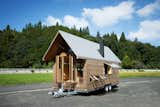Welcome to Tiny Home Profiles, an interview series with people pushing the limits of living small. From space-saving hacks to flexible floor plans, here’s what they say makes for the best tiny homes on the planet. Know of a builder we should talk to? Reach out.
Haruhiko Tagami had been living in his 1960s Eriba Puck when he came across a unique problem: however timeless the travel tailer was, it was not equipped for putting the kettle on. “During winter months, boiling water would result in wall-to-wall condensation, and without absorbent tape, even the sleeping bag would get wet,” Tagami recalls. “Mold gradually grew and the ceiling turned black, and the room began to smell like mold.” Coming from a family that had owned a sawmill, and having once apprenticed as a carpenter, obtaining a second-class architect license (a credential needed in Japan to design smaller buildings), Tagami was well qualified to build a trailer that better suited his needs. “I thought I might be able to build a comfortable wooden one,” he tells us. “So I bought a used bike trailer and built a Usonia-style home out of Japanese cedar.”
That was in 2014. Since, his company, Tiny House Japan, has made several designs that follow Frank Lloyd Wright’s Usonian principles—from a deployable emergency shelter, to an itinerant tea house, to a stationary home made up of two linked modules—that each aims to make the most of a five-and-a-half meter trailer bed. Here, Tagami shares the philosophy behind his work, a few of his past projects, and his latest build that’s ready for tea-making: the Triangular Roof House.
How did you decide to live in and build tiny homes?
My partner and I have sensitivities to sound and pesticides and have lived in and out of various places. Because of these experiences, it was reasonable for us to have a house that we could move around in, rather than live in one place. From a production standpoint, it was also rational that we could build homes for distant clients in our factory.
What makes your tiny homes unique?
Our tiny homes are based on the organic architecture of Frank Lloyd Wright. Influenced by Japanese architecture, Wright’s philosophy led him to the idea of space, the unity of indoors and outdoors, and the idea that all parts should be functional and beautiful, which we are trying to reimport and embody in Japan.
What is the most exciting project you have realized so far?
This house, the Triangular Roof House, is one of the most exciting. Our client, Kani, wanted a house that would work in the snow. We wanted to create a small but comfortable plan, complete with a cozy fireplace, underfloor heating, and an air control system. In the style of old Japanese houses, there’s an irori in the living space, which can be used for heating and cooking. The toilet, shower, and laundry have been combined into one room, creating a generous amount of space throughout the building.
Everything is handmade.
What does one of your base models include?
Base models include a finished living space, the chassis, the plank siding, an EPDM roof, doors, and windows. Everything can be customized, though.
Where are your tiny homes available? Do you have plans to expand to different parts of the world?
We have delivered homes to more than 20 locations in Japan. We hope to be able to export to other parts of the world, but it is very difficult to register our vehicles in other places. So we are not exporting at this time.
How long does it take to get one of your tiny homes after putting down a deposit?
It takes two months for a small design and a year for a large one. We can also assist in installing the home on-site.





















